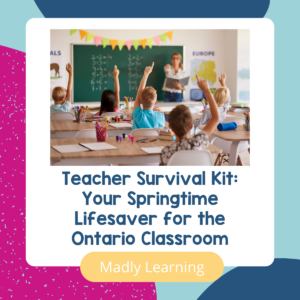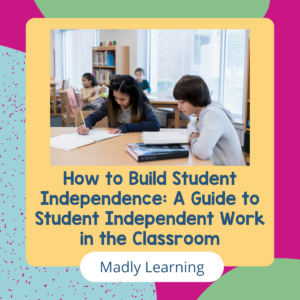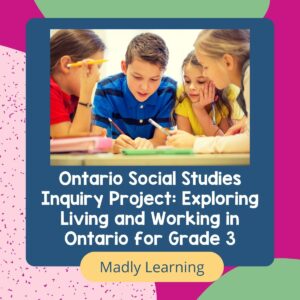I used to teach writing like everyone else.
I would

- pick a writing form
- break it down into steps
- focus on the process of how to write within a form
- repeat this for a few weeks
- have students write within that form
- evaluate their work to see if they could write in the form
Honestly, it worked. I was able to get my assessment data and cover my curriculum.
But…it was boring and my students were less than engaged. Especially those students that had no interest in writing in their form.
Their creativity was gone, stifled, and hidden underneath a bunch of systems and rules that had to be followed. Robot writers were being created. However, writing is personal. For anyone who had ever written outside of the confines of school can tell you writing is a creative and personal process. You pour yourself out onto paper and take risks to share your ideas with others.
So why then as teachers do we take this out of writing to focus on covering the various forms of writing instead of simply letting kids write and experimenting with different writing forms? Just because it is how it has been done in the past doesn’t mean that it needs to be done like that forever. We do it because it is easy, linear, and allows us to teach from a checklist of expectations. Its better for us as teachers, but is it better for students?
I changed how I teach writing 4 years ago.
Faced with a group of boys who refused to write for the previous year, and coming from a feeling that my writing program was hitting expectations but I was spending more time pleading with students to write anything instead of helping them to write better, I looked for an alternative.
Writing Needs To Be Student-Centred
For so long teaching writing has been focused on what the teacher wants to do and what the teacher needs students to do.

This is not student-centred.
Since writing is so personal, we need to give our students more autonomy over what they write. The more autonomy we can give the more engaged students are and the less we need to worry about managing their behaviour.
So what can we do?
Instead of focusing on specific forms of writing such as an adventure story or fable, look at more general forms of writing including
- Narrative
- Expository
- Persuasive
- Descriptive.
Allow students to choose to write anything within these general forms of writing. You can brainstorm different genres of writing the fit under each umbrella of writing forms but the flexibility to write here is important. Junior students (grades 4-6) are just beginning to find their voice as writers. This is a time of great importance because we can shape how they feel about themselves as writers.

I am quickly approaching 40…I am not the best person to decide what a 9-11-year-old is interested in. They are fascinated with bottle flipping, spinning toys, code-able robots, weird arm-swinging dance moves and video games that make absolutely no sense to me.
How could I possibly know them better than they know themselves? Do I really know what topics will excite them tomorrow?
Moreover, with our class sizes ballooning above 30 students with an increasing number of unsupported special education needs, what works and engages one student will not work for another.
So the keys to my writing program here are:
- Allow students to choose what they write
- Use choice boards to help them narrow down on topics across these four general categories.
- Using student-teacher writing conferences with students to talk about each student’s individual next steps as a writer.
- Focus on developing each student’s individual voice as a writer
- Build writing confidence through consistent feedback cycles
Writing Needs To Focus On The Writing Process
 In the Ontario Language Curriculum, there are 13 expectations that focus on the writing process, not including spelling and grammar skills. There is only one that mentions specific writing genres. However, it is not the expectation that states these forms, it is the example text that follows the expectation.
In the Ontario Language Curriculum, there are 13 expectations that focus on the writing process, not including spelling and grammar skills. There is only one that mentions specific writing genres. However, it is not the expectation that states these forms, it is the example text that follows the expectation.
Examples are not our curriculum.
I know that many instructional coaches and leaders over the years have provided lists of all the different forms we should cover at each grade level. I would agree that these are great forms to explore cross strand through oral texts, read-alouds, modelled and shared writing task by looking at the various elements. However, they should not serve as our limitations that restrict student creativity and exploration of their skills as writers.
I argue that these forms should be taught and encouraged, but not be mandated or used to restrict students in their ability to write authentic texts. The focus on the curriculum is much more on the process of writing and steps writers take to write. Focusing on this major element of the curriculum will be far easier to differentiate and allow teachers to be responsive to student needs than simply commanding that all students write a fairytale. Focus on developing skills that follow the writing process instead teach them how to write instead of what to write.
Focus on:
- Brainstorming and generating ideas – for students who are not used to having this type of control over their own learning this is initially very hard for them. Teach them how to dump out their ideas onto a page in no particular order.
- Organizing Ideas – this is a hard one for students because sometimes they just want to write down the story. However, the key to a good piece of writing is a plan. This organizational planning step is universal for every form of writing. How you plan and organize your writing will change depending on your purpose for writing. But instead of walking students down this path, and telling them what to use and how. I feel that giving them a purpose for discovering this is far more meaningful. It also helps them to apply this skill to all areas of writing. We want students to have a method and organization tool to use when writing. Allowing them to know and select the best tool from their toolbox to write more successfully is a far better skill.
- Drafting – Too many kids worry about their ability to spell words correctly the first time, and this fear often prevents them from trying. The last thing I want as a teacher is for a student with great ideas and a strong voice to believe that they are not a good writer just because they can’t spell. Being a good writer and being a good speller are two different skills. The purpose of drafting is to get your ideas down on paper. If you are looking for ways to teach students how to improve their spelling and boost confidence, try this article instead.
- Editing and Revising – This step is key to getting students to fix their spelling and grammar errors. They need to know what to look for and fix these. Combined with explicit lessons on spelling and grammar rules students will learn to be better editors themselves.
- Finally, there is publishing. I believe it is important to recognize not every piece of writing is worthy of being published. Some are simply not worthy. Allow students to look at their body of work, and select only their best work to be published. This allows students to think critically about what they have learned as writers, and to choose samples of their growth.
Students Need More Time For Mastery

I used to think that teaching a form of writing would take me 6 weeks. I now realize that writing takes more time.
Students need to write every day….every day! They need to write for a significant amount of time each day too. According to the guides to effective instruction, this means that students should be writing up to 30min a day.
Teaching writing is a slow burn from the beginning of the year to the end. I let my students make small baby steps with gradual improvement from one draft to the next. We look at where they start and then what they will do next to improve. Slowly students will gain confidence as writers as they believe in themselves to do more of what they are capable of.
Everyone can write and everyone has something to say. It is my job as the teacher to focus on each students’ strengths as a writer to help them improve areas of weakness. Each student will be different in what they need and what they are strong with. They can learn from me, learn from peers, and learn from experience.
Validating their voice is key to engagement in writing. Students will do more of what they feel they are successful in. They will work hard to achieve their goals. Many times they just need a cheerleader in their corner cheering them on.
Try these steps for success:
-
Meet with students regularly:Discuss their strengths and needs as writers. Provide timely feedback that supports and guides them towards their next steps as writers.
-
Have high expectations.Believe that students can do hard things and you will be there along the way but you believe deep in their soul they have the potential to be amazing writers. Some will need permission to fail (even though they won’t). Others will need a push to do more. Some will need a soft place to land full of encouragement, while others will need failure before growth and some will need a clear target to hit. You as the teacher will determine what each student needs from you to move ahead.
-
Focus on the process, not the product. Worry less about which forms they write in, and focus more on the path they take to get there. Allow students to experiment with different forms, and push and guide them along the way.
- Expose students to different writing forms through modelled and shared reading, oral language, and media texts. Identify the features of these texts, analyze them, replicate these in shared writing activities. Remember students simply have to write in a variety of forms, but the exact forms that they should write are not prescribed in the curriculum. Stick to a wide variety of specific forms within the four categories I mentioned above. Allow students the freedom and flexibility to choose a form. Let them decide which best suits their style as a writer. Let them hop back and forth between forms, and build on one skill over time.
- Use a spiralled approach to your literacy program. Revisit topics over time. Link ideas together cross strand so that students can see the connection between reading, writing, oral language, and media.
So in summary…
Stop being the only one who decides what students should do during writing time. Instead, allow students to choose what they write about. Let them develop their own personal voice as a writer.
Stop focusing on specific writing forms and start focusing more on the process of writing.
Stop expecting students to master writing skills in short windows of time. Instead, look at building small areas of skill growth over time. By the time you are done, students will be begging for more writing time!

Get started planning your language arts program now! Learn how to embeds students’ voice and choice, focus on the process of writing, and allow students to master skills through a spiralled approach. Sign up for my free training here or check out the program now!.

Want to hear more from Patti? Check out her blog or find her on Facebook and Instagram!






